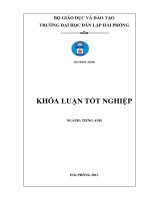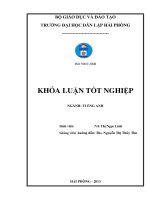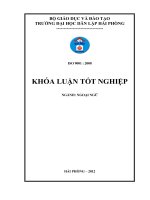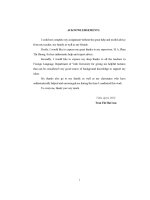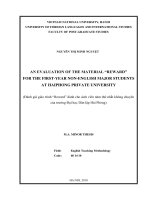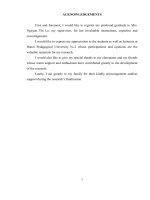A study on how to improve english skill for the first year english major students in hai phong private university
Bạn đang xem bản rút gọn của tài liệu. Xem và tải ngay bản đầy đủ của tài liệu tại đây (1.4 MB, 63 trang )
BỘ GIÁO DỤC VÀ ĐÀO TẠO
TRƯỜNG ĐẠI HỌC DÂN LẬP HẢI PHÒNG
-------------------------------
ISO 9001:2015
KHÓA LUẬN TỐT NGHIỆP
NGÀNH: NGÔN NGỮ ANH
Sinh viên
: Lương Thị Huyền
Giảng viên hướng dẫn: Th.S Nguyễn Thị Quỳnh Hoa
HẢI PHÒNG - 2019
BỘ GIÁO DỤC VÀ ĐÀO TẠO
TRƯỜNG ĐẠI HỌC DÂN LẬP HẢI PHÒNG
-----------------------------------
A STUDY ON
HOW TO IMPROVE ENGLISH SPEAKING SKILL FOR THE
FIRST YEAR ENGLISH MAJOR STUDENTS IN HAI PHONG
PRIVATE UNIVERSITY
KHÓA LUẬN TỐT NGHIỆP ĐẠI HỌC HỆ CHÍNH QUY
NGÀNH: NGÔN NGỮ ANH
Sinh viên
: Lương Thị Huyền
Giảng viên hướng dẫn: Th.s Nguyễn Thị Quỳnh Hoa
HẢI PHÒNG - 2019
BỘ GIÁO DỤC VÀ ĐÀO TẠO
TRƯỜNG ĐẠI HỌC DÂN LẬP HẢI PHÒNG
--------------------------------------
NHIỆM VỤ ĐỀ TÀI TỐT NGHIỆP
Sinh viên: Lương Thị Huyền.
Mã SV: 1412751113
Lớp: NA1804.
Ngành: Ngôn ngữ Anh.
Tên đề tài: A study on how to improve english skill for the first year
English major students in Hai Phong private university.
NHIỆM VỤ ĐỀ TÀI
1. Nội dung và các yêu cầu cần giải quyết trong nhiệm vụ đề tài tốt nghiệp
( về lý luận, thực tiễn, các số liệu cần tính toán và các bản vẽ).
……………………………………………………………………………..
……………………………………………………………………………..
……………………………………………………………………………..
……………………………………………………………………………..
……………………………………………………………………………..
……………………………………………………………………………..
……………………………………………………………………………..
2. Các số liệu cần thiết để thiết kế, tính toán.
……………………………………………………………………………..
……………………………………………………………………………..
……………………………………………………………………………..
……………………………………………………………………………..
……………………………………………………………………………..
……………………………………………………………………………..
3. Địa điểm thực tập tốt nghiệp.
……………………………………………………………………………..
……………………………………………………………………………..
……………………………………………………………………………..
CÁN BỘ HƯỚNG DẪN ĐỀ TÀI TỐT NGHIỆP
Người hướng dẫn thứ nhất:
Họ và tên: Nguyễn Thị Quỳnh Hoa.
Học hàm, học vị: Thạc sĩ.
Cơ quan công tác: Trường Đại học Dân lập Hải Phòng.
Nội dung hướng dẫn: A study on how to improve english speaking skill for
the first year English major students in Hai Phong private university.
Người hướng dẫn thứ hai:
Họ và tên:.............................................................................................
Học hàm, học vị:...................................................................................
Cơ quan công tác:.................................................................................
Nội dung hướng dẫn:............................................................................
Đề tài tốt nghiệp được giao ngày … tháng ….. năm …..
Yêu cầu phải hoàn thành xong trước ngày …. tháng ….. năm ……
Đã nhận nhiệm vụ ĐTTN
Đã giao nhiệm vụ ĐTTN
Sinh viên
Người hướng dẫn
Lương Thị Huyền
Th.s Nguyễn Thị Quỳnh Hoa
Hải Phòng, ngày ...... tháng........năm 20..
Hiệu trưởng
GS.TS.NGƯT Trần Hữu Nghị
CỘNG HÒA XÃ HỘI CHỦ NGHĨA VIỆT NAM
Độc lập - Tự do - Hạnh phúc
PHIẾU NHẬN XÉT CỦA GIẢNG VIÊN HƯỚNG DẪN TỐT NGHIỆP
Họ và tên giảng viên:
...................................................................................................
Đơn vị công tác:
........................................................................ ..........................
Họ và tên sinh viên:
.......................................... Chuyên ngành: ...............................
Nội dung hướng dẫn:
.......................................................... ........................................
............................................................................................................................
Tinh thần thái độ của sinh viên trong quá trình làm đề tài tốt nghiệp
..............................................................................................................................................
...... ..............................................................................................................................................
...... ..............................................................................................................................................
...... ..............................................................................................................................................
...... ..............................................................................................................................................
...... ..............................................................................................................................................
1. Đánh giá chất lượng của đồ án/khóa luận (so với nội dung yêu cầu đã đề ra trong
nhiệm vụ Đ.T. T.N trên các mặt lý luận, thực tiễn, tính toán số liệu…)
...... ..............................................................................................................................................
...... ..............................................................................................................................................
...... ..............................................................................................................................................
...... ..............................................................................................................................................
...... ..............................................................................................................................................
3. Ý kiến của giảng viên hướng dẫn tốt nghiệp
Được bảo vệ
Không được bảo vệ
Điểm hướng dẫn
Hải Phòng, ngày … tháng … năm ......
Giảng viên hướng dẫn
(Ký và ghi rõ họ tên)
QC20-B18
CỘNG HÒA XÃ HỘI CHỦ NGHĨA VIỆT NAM
Độc lập - Tự do - Hạnh phúc
PHIẾU NHẬN XÉT CỦA GIẢNG VIÊN CHẤM PHẢN BIỆN
Họ và tên giảng viên:
..............................................................................................
Đơn vị công tác:
........................................................................ .....................
Họ và tên sinh viên:
...................................... Chuyên ngành: ..............................
Đề tài tốt nghiệp:
......................................................................... ....................
1. Phần nhận xét của giáo viên chấm phản biện
...... ..........................................................................................................................................
...... ..........................................................................................................................................
...... ..........................................................................................................................................
...... ..........................................................................................................................................
...... ..........................................................................................................................................
...... ..........................................................................................................................................
...... ..........................................................................................................................................
2. Những mặt còn hạn chế
..........................................................................................................................................
...... ..........................................................................................................................................
...... ..........................................................................................................................................
3. Ý kiến của giảng viênchấm phản biện
Được bảo vệ
Không được bảo vệ
Điểm hướng dẫn
Hải Phòng, ngày … tháng … năm ......
Giảng viênchấm phản biện
(Ký và ghi rõ họ tên)
QC20-B19
TABLE OF CONTENTS
ACKNOWLEDGEMENTS ................................................................................ v
PART I: INTRODUCTION ................................................................................ 1
1.Rationale .......................................................................................................... 1
2. Aims of the study and the scope of the study .................................................. 1
3.The scope of the study ...................................................................................... 2
4.Methods of study .............................................................................................. 2
5. Design of the study .......................................................................................... 3
PART II. DEVELOPMENT ............................................................................. 4
CHAPTER I: THEORETICAL BACKGROUND ......................................... 4
1.Definition of speaking skill .............................................................................. 4
2.What is speaking skill ....................................................................................... 7
3. Types of speaking ............................................................................................ 8
3.1.Form-focused speaking ................................................................................. 8
3.2 Meaning-focused speaking ............................................................................ 8
3.3.Opportunities to improve fluency .................................................................. 8
4.Relationship between speaking and three other skills ...................................... 9
4.1. Relationship between speaking and listening .............................................. 9
4.2 Relationship between speaking and reading .................................................. 9
5.The purpose of speaking skills ....................................................................... 10
6.Activities to improvestudent’s speaking skill ................................................. 11
6.1Information-gap activities ............................................................................ 11
6.2.Dialogues and role-plays ............................................................................. 11
6.3.Activities using pictures .............................................................................. 12
6.4. Using games ............................................................................................... 13
7. Characteristics of a successful speaking activity ........................................... 14
7.1. Learners talk a lot ....................................................................................... 14
7.2. Participation is even ................................................................................. 14
7.3. Motivation is high ..................................................................................... 14
7.4. Language is of an acceptable level ........................................................... 14
i
CHAPTER 2: METHODLOGY .................................................................... 15
1. The reality of learning and teaching English speaking skill for the first year
English major students at HP ............................................................................ 15
1.1 The teaching staff ........................................................................................ 15
1.2 The student .................................................................................................. 15
1.3 English teaching and learning condition at Hai Phong Private University .. 16
2.The survey questionaires ................................................................................ 17
2.1 The design of the survey questionaires ........................................................ 17
2.2. The data analysis ........................................................................................ 18
2.2.1. The students’ English learning time ........................................................ 18
2.2.2 Which skill is the most difficult................................................................ 19
2.2.3 The students’ attitude toward learning English speaking.......................... 19
2.2.4 The students’ perceived importance of English speaking ......................... 20
2.2.5 The students’ frequency of speaking English in class time ...................... 21
2.2.6 The students’ impression on the English lessons ...................................... 22
2.2.7 The result from students’ opinions on the current teaching method ......... 23
2.2.8 The students’ time to take part in extra-activities ..................................... 25
2.Findings and discussion of findings ............................................................... 25
CHAPTER 3 : SOME SUGGESTED TO IMPROVE ENGLISH
SPEAKING SKILL ......................................................................................... 27
1.Teaching methods to improve speaking skills ................................................ 27
3. The language game ........................................................................................ 34
3.1 Advantages of language games ................................................................... 34
3.3.Work group and pair group ......................................................................... 38
4.Telephone conversations ................................................................................ 38
5. Applicibility of Internet in studying speaking ............................................... 39
6. Picture ...............................................................................................................
...............................................................................................................................
7. TV and Video ................................................................................................ 40
8. Speaking English to yourself ......................................................................... 41
ii
9. Take part in English club ............................................................................... 41
10. Watch your favorite English videos ............................................................ 41
11. Watch English movies and TV shows ......................................................... 42
12. Check grammar with online English tests ................................................... 42
13. Read e-books, articles, magazines every day............................................... 42
14. Write an English essay ................................................................................ 42
15. Chat English anywhere ................................................................................ 42
16. Practice reflexes by practice ........................................................................ 43
17. Hang man game ........................................................................................... 46
PART III: CONCLUSION ............................................................................. 49
LIST OF REFERENCES................................................................................ 50
SURVEY QUESTIONAIRE ........................................................................... 51
iii
LIST OF CHARTS
Chart 5 : Students’frequency of speaking English in class time ........................ 22
Chart7 : The students’ opinions on the current teaching method ....................... 24
iv
ACKNOWLEDGEMENTS
In the process of doing the graduation paper, I have received a lot of help,
assistance, guidance, encouragement and idea contribution from my teachers,
family and friends.
My great gratitude goes to my supervisor Nguyen Thi Quynh Hoa (M.A)
for her enthusiastic guidance, very helpful ideas and instructions for the
preparation and her corrections during the completion of this graduation paper.
Secondly, I would like to express my sincere thanks to Ms. Tran Thi
Ngoc Lien (MA), the Dean of Foreign Language Department and all the
teachers at Haiphong Private University for the precious and useful lessons in
my study process that helped me a lot during graduation time.
It woult be a mistake if I didn’t mention the first year English major at
Hai Phong Private University who took part in my survey questionnaire
enthusiastically. Thanks to their participation, I had data survey, analysis and
gave the appropriate solutions.
Last but not least, I would like to give my heartfelt thanks to my family, my
friends who always, encourage and inspirit me to complete this graduation paper.
Hai Phong, February, 2019
Student
Luong Thi Huyen
v
PART I: INTRODUCTION
1. Rationale
Nowadays, it can’t bedenied that English is becoming the common tounge
of our global village. Whether you live and work in an English speaking country
or need English for travelling and fun, English is the passport to the success and
a deeper understanding of our quickly changing word. Therefore, learning
English is very important and necessary because mastering English is the best
and the shortest way for us to have a great deal of opportunities to reach the
goals of life. The English learner, from elementary pupils to students, from
workers to government employers study English with the interest and enthusiam.
However, for Vietnamese students, espeacially the 1st year
English major
students, they have a lot of dificulties in learning and practising English
speaking skill. They often fall into confusion when speaking English because
lack of knowledge, confidence, and the good learning method as well. Besides,
the learning passive environment with the same and boring lessons without the
interesting extra- activities prevent them from practising and improving English.
That is the main reason why they don’t get the effective result in learning
English, especially the English speaking skill.
Due to the reasons above, I have made a sketry presentation on some
effective method of studying English with the hope that this can help the first
year English major students at Hai Phong Private University will study English
better in the near future. Moreover, one of my suggested method is to study
English speaking through extra- activities. That is the reason why I have decided
to choose the research with the title “ How to improve English speaking skill for
the first year English major students at Hai Phong Private University’’.
2. Aims of the study and the scope of the study
- Aims of the study
My study is about to help the first year English major students at Hai
Phong Private University improve their speaking skill to prepare for them to the
1
basic knowledge of speaking skill with higher requirement for the next graders.
To sumarize the above, my study is aimed at:
- Covering background knowledge of speaking
- Finding out reality of teaching and learning English at HaiPhong Private
University.
- Finding out appropriate techiniques for teaching speaking lessons which
draw students’s attention into the lesson. The students will feel interested,
enjoyable and funny when they come into the speaking lesson. Some good
techniques, especially the extra- activities will be given out inorder to improve
their speaking skill.
It should be noted that this paper shouldn’t be considered exclusive to
English major students at Hai Phong Private university. Infact, the fundamental
concepts and result of this paper can be applied to most English learners.
3.The scope of the study
There are so many different material resources and researchers that
require a lot of time and effect while my personal experien ce is limited.
Therefore, this study can only foucs on study some effective techniques in
studying English speaking skill, especially through the extra- activities for the
first year English major students at Hai Phong Private University.
I hope that this study is a good reference material for the English major
as well as all students who wish to get the higher speaking skill.
4.Methods of study
To finish this study, I myself carry out some following methods.
- Researching on reference books and websites.
- Attending English speaking periods at English non- major classes at Hai
Phong Private University.
- Interviewing and conducting the survey questionaires for the first year
English major students at Hai Phong Private University with a point to find out
their recognizations, attitudes of the matter and the difficulities they encounter
when practising English speaking skill.
2
- Basing on my personal experience from my under graduating time in
the university through speaking skil at class.
5. Design of the study
A table of contents with pages numbers in which they are presented with
help readers have a clear overview of the research proposal. It also helps readers
find the part they need more easily and quickly. The study contains of three
parts:
Part I: The introduction are literature review, aims, scope, methodsand the
design of the study.
Part II: The development are three chapters:
- The first chapter is Literature Review which provides readers the
overview of speaking skill through the extra- activities.
- The second chapter is the Survey Questionaire for the first year English
nonmajor students. This chapter refers to the analysis and the findings obatained
from the survey questionaires and evaluations from students, interviewing
teachers to find out the necessary informations and the discussion of the findings
from the survey.
- The third chapter focuses on suggesting applicable techniques to teach
and practisning English speaking skill fo rthe first year English non- major
students.
Part III is the conlusion which sumarized all the presented informations
3
PART II. DEVELOPMENT
CHAPTER I: THEORETICAL BACKGROUND
Firstly, to master the techniques of studying speaking skill, especially for
the first year English major students of Hai Phong Privste University, it is
imposible not to mention the concept of speaking.
1.Definition of speaking skill
Different people use the term “ speaking” in different ways, which can
cause much confusion. Speaking a foreign language ususally seems much harder
than learning to write and and read, especially to the first year English nonmajor students. Often the most important problems peple have with forein
language is that they can not speak their thinkings and their ideas as well. In fact,
it is likea vicious circle: they make mistakes, they become afraid of speaking
and thus they never get the practise which would be able to correct their
mistakes. Most of the beginning learners do not understand axactly “ what is
speaking?”. We only regard speaking sd a simple, easy process that involves
speaking the words, the ideas…by speaking out what they think without the
correct. So, we had better start by making sure that we are thinking about the
same thing when we use this term. As the first step, it would be use ful to
undersytand “what is speaking”. According to the Oxford Pocket dictionary of
Current English 2009 “ Speaking is the action of conveying information or
expressing ones thoughts and feelings in spoken language. And speaking used to
indicate the degree of accuracy intended in a statement or the point of view from
which it is made.”
In the book “ Developing speaking skill” of David Scheter, published on
1999, there is a definition that: “ Speaking is to uuter words or articulate sounds,
as human beings to express thoghts by words, as the organs may be so
obstructed that a man may not be able to speak”. Meanwhile in the book
“ Collins Cobuild English for avanced learner 4th edition, published in 2007
4
definites that “ Speaking is the activitiey of giving speechs and talks, to indicate
the opinion you are giving”.
“ Speaking is also understood is the productive skill in the oral mode. It, like the
oral skills, is more complicated than it seems at first and involves more than just
pronouncing words” ( In the website Lingua Link Library, Version 3.5,
published on CD.ROMby SIL International 1998).
Speaking is an interactive process of constructing meaning that involves
producing and receiving and process information (Brown, 1994; Burns &
Joyce, 1997). Its form and meaning are dependent on the context in which it
occurs, including the participants themselves, their collective experiences, the
physical environment, and the purposes for speaking. It is often spontaneous,
open-ended, and evolving. However, speaking is not always unpredictable.
Language functions (or patterns) that tend to recur in certain discourse
situations (e.g., declining an invitation or requesting time off from work), can
be identified and charted (Burns &Joyce, 1997). For example, when a
salesperson asks "May I help you?" the expected discourse sequence includes
a statement of need, response to the need, offer of appreciation,
acknowledgement of the appreciation, and a leave-taking exchange. Speaking
requires that learners not only know how to produce specific points of
language such as grammar, pronunciation, or vocabulary (linguistic
competence), but also that they understand when, why, and in what ways to
produce language (sociolinguistic competence). Finally, speaking has its own
skills, structures, and conventions different from written language (Burns &
Joyce, 1997; Carter & McCarthy, 1995; Cohen, 1996). A good speaker
synthesizes this array of skills and knowledge to succeed in a given speaking act.
According to Chaney (1998), speaking is the process of making and
sharing meaning by using verbal and non-verbal symbols in different contexts.
Brown (1994) and Burns and Joyce (1997) defined speaking as an interactive
process of making meaning that includes producing, receiving, and processing
information.
5
Bygate (1987) defined speaking as the production of auditory signals to
produce different verbal responses in listeners. It is regarded as combining
sounds systematically to form meaningful sentences. Eckard and Kearny (1981),
Florez (1999), Howarth (2001), and Abd El Fattah Torky (2006) defined
speaking as a two–way process including a true communication of opinions,
information, or emotions. This top-down view regards the spoken texts as the
collaboration between two or more people in the shared time and the shared
context. Whilst Pendidikan Nasional stated, based on Competence Based
Curriculum speaking is one of the four basic competences that the students
should gain well. It has an important role in communication. (Departmen
Pendidikan Nasional, 2004 p.1). In carrying out speaking, students face some
difficulties; one of them is about language its self. In fact, most of students get
difficulties to speak even though they have a lot of vocabularies and have
written them well. The problems are afraid for students to make mistakes. While
Wallace (1978) stated that oral practice (speaking) becomes meaningful to
students when they have to pay attention to what they are saying. Thus, the
students can learn better on how to require the ability to converse or to express
their ideas fluently with precise vocabularies and good or acceptable
pronunciation.
Speaking ability is the students’ ability in expressing their ideas orally,
which is represented by the scores of speaking. Speaking is only an oral trail of
abilities that it got from structure and vocabulary, Freeman (in Risnadedi, 19
2001) stated that speaking ability is more complex and difficult than people
assume, and speaking study like study other cases in study of language,
naturalize many cases to language teachers.
In conclusion,speaking skill is always considered as a domain of language
and linguistic proper. Therefore, Clark and Clark (in Nunan, 1991, p.23) stressed,
“speaking is fundamentally an instrument act”. Speakers talk in order to have
some influences on their listeners. It is the result of teaching learning process.
Students’ skill in conversation is mainly aimed at in terms of teaching speaking
6
skill, it becomes vitally aspect in language teaching and learning success if
language functions as a system for conveying meaning, as Nunan (1991, p.39)
states that the successful in speaking is measured through someone’s ability to
carry out a conversation in the language.
2.What is speaking skill
Speaking is the productive skill in the oral mode. It, like the other skills, is
more complicated than it seems at first and involves more than just
pronouncingwords.
There are three kinds of speaking situations in which we find ourselves:
Interactive
Partially interactive
Non-interactive
Interactive speaking situations include face-to-face conversations and
telephone calls, in which we are alternately listening and speaking, and in which
we have a chance to ask for clarification, repetition, or slower speech from our
conversation partner. Some speaking situations are partially interactive, such as
when giving a speech to a live audience, where the convention is that the
audience does not interrupt the speech. The speaker nevertheless can see the
audience and judge from the expressions on their faces and body language
whether or not he or she is being understood.
Some few speaking situations may be totally non-interactive, such as when
recording a speech for a radio broadcast.
Here are some of the micro-skills involved in speaking. The speaker has to:
Pronounce the distinctive sounds of a language clearly enough so that
people can distinguish them. This includes making tonal distinctions.
Use stress and rhythmic patterns, and intonation patterns of the
language clearly enough so that people can understand what is said.
Use the correct forms of words. This may mean, for example, changes
in the tense, case, or gender.
Put words together in correct word order.
7
Use vocabulary appropriately.
Use the register or language variety that is appropriate to the situation
and the relationship to the conversation partner.
Make clear to the listener the main sentence constituents, such as
subject, verb, object, by whatever means the language uses.
Make the main ideas stand out from supporting ideas or information.
Make the discourse hang together so that people can follow what you
are saying.
3. Types of speaking
In speaking class, according to Burns, A & Joyce, H. (1997), students
must be exposed to three key items:
3.1.Form-focused speaking
Form-focused instruction, that is, attention to details of pronunciation,
grammar, vocabulary, and so forth… When learners begin speaking in another
language, their speaking will need to be based on some form-focused learning.
An effective way to start is to base speaking on some useful, simple memorized
phrases and sentences. These may be greetings, simple personal description, and
simple questions and answers. As their proficiency and experience in the
language develop, most of these sentences and phrases may be re-analyzed and
incorporated into the learners‟ system of knowledge of the language. Language
use based on memorization can be the starting point for more creative use of the
language.
3.2 Meaning-focused speaking
Meaning-focused instruction, that is, opportunities to produce meaningful
spoken messages with real communicative purposes.
In addition to form-focused speaking, language learners should be
exposed to and given chances to practice and use meaning-focused
communication, in which they must both produce and listen to meaningful oral
communication.
3.3.Opportunities to improve fluency
8
Elements of all these above should be presented throughout a speaking
program with emphasis on form-focused instruction at the elementary levels and
as the learners ' progress on meaning-focused instruction at the higher level.
4.Relationship between speaking and three other skills
According to Forseth. R and Carol. H (1994:43), speaking related to the
following skills:
4.1. Relationship between speaking and listening
In learning English as a foreign language, the learner cannot develop
speaking skills unless he develops listening skills; to successful conversation, he
must understand what is said to him. Later on, the ability to understand the
native speaker in direct conversations, on the radio or tape may be very
important for him to further study the language and communicate in it.
Besides, listening to spoken English is an important way of acquiring the
language of “picking up” structures, vocabulary. In the Vietnamese situation
where the learners do not have a chance to hear English spoken around them
every day and cannot acquire it easily the teacher needs to give them as much
opportunity to listen to spoken English on tape as possible.
The speaker usually directs his speech at the listener, taking the listeners
character, intention, attitude, etc into account when speaking and often respond s
directly to her reactions, whether verbal or non-verbal, by changing or adapting
this discourse.
4.2 Relationship between speaking and reading
Like listening, a receptive skill, reading also has some relations with
speaking in term of developing each other. Normally, a speaking lesson begins
by text which students should find some information for their speaking activities.
It may be a paragraph, a magazine, a report, and a book…this show that, reading
supports speaking by providing necessary information. Students must have
enough information, then, they can use it in speaking production. Therefore,
students should be encouraged to read for not only having more information,
9
knowledge but also improving vocabulary.
4.3 Relationship between speaking and writing
The relationship between speaking and writing, firstly, will look at factors
affecting the choice between speaking or writing and how these factors affect
the style and language used. The factors include being face-toface, saving face,
permanence, interactivity in for amativeness, and context dependence in which
both speaking and writing can be located , rather than occurring as polar
opposites. A spoken and written on the same topic will different in language use
relating to grammar, lexis, and style.
5.The purpose of speaking skills
It is hard to describe a thing without speech, if we don’t use language to
express our mean or purpose to do something, it might be distorted or difficult to
get. Thus, speaking is always considered the most crucial action of human being.
There might be no other effective way to communicate than speaking. The four
basic skills of listening, speaking, reading and writing are all connected. It is
essential to be proficient in all of these skills to be a competent communicator.
However, it is worth mentioning that speaking skill tends to help the learners
benefit more with some specific advantages. The ability to express thoughts,
emotions, and so on can provide a learner with these followingadvantages:
Ability to hold the leadership. Business managers, educators, military
leaders, lawyers, and many others leaders need to develop their speaking skills
so that they are capable of mastering public speaking. Speaking clearly and
confidently can help them get the attention of an audience, providing the
precious opportunity for those speakers to transfer their messages and make
them well-known by their speech. Wise and successful speakers are who can
gain and then hold the attentions of their audiences.Also how well-chosen the
speakers select the vocabulary, organized and expressed things can determine
the level of impact made after the speech.
The ability to be outstanding. When it comes to speaking skills, everyone
tends to think of it as a common skill. However, ability to excel and to speak
10
English effectively and confidently is not an ordinary ability. Many people are
extremely afraid of public speaking. As a research shows that more than a half
of all population in the world are terribly afraid of public speaking while others
are not so competent to form thoughts into sentences and make those words
convincing. More notably is that in the world there are not so many talent
speakers but if a speaker whose skills are good and developed with constant
opinions and much effort can stand out.
Ability to be popular. A well-developed speaker can strengthen his
negotiation skills. That speaker can sign many important contracts and bring
about profits not only for his company but also himself. Additionally, his
selfconfidence is improved as well as a growing sense of comfort,which comes
from speaking in front of big group of audiences. The fame for excellent speech
in speaking can accumulate day by day, thereby creating a certain trust of the
speaker. “Speaking skills can enhance one’s personal life; thereby bringing
about the well-rounded growth we should all seek” (Gerald Gillis,2013, p.2).
6.Activities to improvestudent’s speaking skill
In order to encourage students to speak, teachers need to have various
activities. These activities given by Hayriye Kay from web website
can be a suggestion and applicable in a speaking lesson.
6.1Information-gap activities
One excellent way to make speaking tasks communicative is to use
informationgap activities, in which the students have different information and
they need to obtain from each other in order to finish a task. In this activity,
students are supposed to be work in pair. Information-gap activities serve many
purposes such as solving a problem, or collecting information. Also, each
partner plays an important role because the task can not be completed if the
partner does not provide the information the other needs. These activities are
effective because everybody has chance to talk in the target language.
6.2.Dialogues and role-plays
Two problems with most dialogues are presented in textbooks:
11
-The lack of natural intonation: The natural speech of native speakers is
often phrases or sentence fragments full of pauses, false starts, and repetitions.
- The way most dialogues are taught: Teachers ask students to memorize
dialogues by heart.
Two ways to make dialogues more communicative:
*Turning dialogues into role plays: students are asked to work in pair:
they pretend they are acting as someone else. Then teachers ask a few pairs to
perform the dialogue in front of the whole class, speaking in different moods
such as happy, irritated, bored, or in different role relationships such as parents
and a child, husband and wife, two friends, or making the dialogue longer by
adding more lines.
Another point is that teachers should ask students to come to the front of
class before telling them the situation then give them few minutes to think about
that. Thanks to this, students will speak more spontaneously. Factors that affect
the success of role-plays (Ur, 1996:133)
Teachers enthusiasm;
Careful instructions;
Clear situation and roles;
Making sure that the students have the language they will need to carry
out the role-play
* Using cue cards: this way, an information gap is formed because each
student only sees one cue card so he does not know what the other person is
going to say.
6.3.Activities using pictures
Pictures are invaluable in speaking activities. Appropriate pictures
provide cues, prompts, situations and non-verbal aid for communication. There
are many different information-gap activities that can be designed around
pictures.
12
Kind 1: use two pictures which look identical to each other at first
glance but actually have several differences then teachers ask students to find
the differences.
Kind 2: give students just one picture and ask them to describe what is
in picture. This activity fosters the creativity and imagination of the learners as
well as their public speaking skill.
Kind 3: give students some pictures which describe a story but they are
in incorrect order then ask students to reorder them and tell class about given
story.
6.4. Using games
The benefits of using games in speaking lesson can be summed up in 9
points: (www.teachingenglishgames.com )
Learners are the main factor
Promote communicative competence
Create a meaningful context for language use
Increase learning motivation
Reduce learning anxiety
Integrate various linguistic skills
Encourage creative and spontaneous use of language
Construct a cooperative learning environment
Foster participatory attitudes of the students.
Teachers can divide class into small groups or let the whole class play a game.
There are various kinds of game and each kind helps students develop heir skill.
Teachers can choose one suitable with students' ability. Some games: art
master, bingo, cross-word…
It can not be denied that these techniques are so interesting, so if teachers
can apply some of them to make their lesson more attractive, students will
eagerly involve in the lesson.
7. Characteristics of a successful speaking activity
(Extracted from website: www.caslt.org)
13

